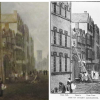Town and gown: Authentica habita and the Privilegium scholasticum
Commentary
Town and gown. In paintings and engravings of Oxford created well into the nineteenth century – of which this view of the High Street in 1809-10 by J. M. W. Turner is perhaps the most famous – the city is typically populated partly by figures dressed in academic caps, hoods and gowns. Today – when such garments are reserved for rare, formal occasions – it is easy to imagine that these are mere decorative touches, designed to remind the viewer of the special character of a university town. But in fact, the wearing of these vestments was obligatory, not only for the formal assemblies of the University in Congregation and Convocation, nor even merely for lesser University functions such as sermons, lectures and disputations: they were also required as part of the daily life of the University community. Their primary purpose (discussed here) was to distinguish University men from townsmen. Their secondary purpose (illustrated by the following image) was to distinguish University men from one another according to their various degrees and faculties.
Authentica habita and the Privilegium scholasticum. Distinctive academic clothing of this kind is almost as old as the university as a legally recognised institution. From the mid-twelfth century onward, scholars from across Europe began travelling to Bologna to study civil and canon law. During their travels, and as foreigners in the Italian city, they lacked legal protection. In particular, they were vulnerable to the ‘right of reprisal’, in which their property could be confiscated to settle debts incurred, not only by themselves, but by their countrymen. If university learning was to spread, scholars studying in foreign lands needed legal protection. In order to encourage the spread of higher learning, the Holy Roman Emperor, Frederick I Barbarossa (1122–1190), issued a document known as the Authentica habita or Privilegium scholasticum, which established in law the rights and privileges of universities and the people studying at them.
Fundamentally, this document extended to scholars rights and protections similar to those already enjoyed by the clergy. Like secular and monastic clergy, matriculated members of the university corporation would be immune from civil jurisdiction: instead, they would be tried by in the bishop’s court or by their own masters in university courts, provided that they distinguished themselves by wearing a variant of clerical dress. As well as immunity from the right of reprisal, they also gained freedom to travel for the purposes of study and teaching. Confirmed by Pope Alexander III and incorporated by the emperor into the Justinian law code, the Authentica habita provided a legal foundation upon which the subsequent history of medieval and early modern universities rests.
Long after the Reformation deprived the clergy of their status as a separate estate under the jurisdiction of ecclesiastical rather than secular courts, members of the university communities in Oxford and Cambridge continued to enjoy this status as a separate community under its own jurisdiction, immune from prosecution in civil courts. The wearing of academic garments in images such as this was the visible symbol that members of the university community were in Oxford but not of Oxford, as least as far as their subjection to civic authority was concerned.
Image. View of the High Street, Oxford, by Joseph Mallord William Turner (1775–1851). Oil on Canvas, 68.5 x 100.3 cm. Ashmolean Museum: WA2016.48. Source: Wikimedia (public domain). A series of preliminary watercolour sketches for this painting are preserved in the Tate. The painting was commissioned as the basis for an engraving by the Oxford print-seller, James Wyatt: see British Museum, no. 1857,0520.444 and Sanders of Oxford. A fund-raising campaign was undertaken in 2015 to save this painting for the nation and obtain it for the Ashmolean.
Further reading. Pearl Kibre, Scholarly Privileges in the Middle Ages: The Rights, Privileges, and Immunities, of Scholars and Universities at Bologna, Padua, Paris, and Oxford (London, 1962), pp. 1-17; Paolo Nardi, ’Relations with Authority’, in Hilde de Ridder-Symoens (ed.), Universities in the Middle Ages [= A History of the University in Europe, vol. I] (Cambridge, 1992), here pp. 77-81; Martin Butlin and Evelyn Joll, The Paintings of J.M.W. Turner, revised edn, 2 (New Haven and London, 1984), p. 102.
Credits: Howard Hotson (December 2018)

